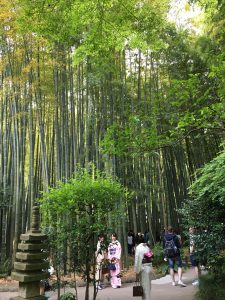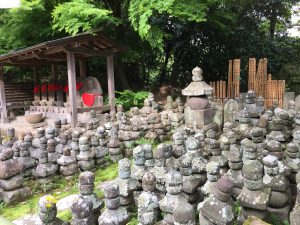Time for a day trip out of the big city. Kamakura, just an hour from Tokyo, and situated on Sagami Bay, this ancient town houses more than 60 religious buildings, temples, and shrines and was a breeding ground for Zen Buddhism. Kamakura was chosen as the capital by Yoritomo, who was appointed shogun and established the Kamakura shogunate which lasted until 1333. This shifted the center of Japanese politics from Kyoto to Kamakura and was the first samurai regime in Japan; the supremacy of the samurai lasted through the Tokugawa shogunate, which collapsed in 1867, as Japan tilted to the West. We spent the day roaming the various temples and shrines, managing to only fit 5 into our itinerary.
The first day of Golden Week meant that the streets were crowded with Japanese, many in kimono and traditional costumes. It also appeared that many of the local faithful were having calligraphy added in a notebook of credentials — as if they were making the rounds of the temples and collecting the “stamps”. And we witnessed two weddings take place at the main shrine. We’ve missed the cherry blossoms, but there are beautiful wisteria and azalea in bloom, and everyone beautiful little hidden gardens.
Tsurugaoka Hachimangu was the center of the city and the primary place for most rituals during the long Kamakura period. It is a typical example of Edo shrine architecture, having been build in 1828. A beautiful feature of the area is the avenue of cherry trees, which extends for 1,500m from the torii gate to the shrine; they had been planted at Yoritomo’s request to honor the kami and improve his wife’s chances of conceiving. At most of these shrines one can shake a box of sticks and get a fortune based on the number on the stick that comes out. If you’re unhappy with the fortune, or if it’s bad luck, you’re encouraged to tie the fortune on a display at the temple. There were lots of fortunes tied up; luckily I had good ones!
Next up was Hokokuji Temple, a Zen temple established in 1334. The primary attraction of this shrine is the bamboo forest. Over 2,000 moso-bamboo trees are there — the largest type of bamboo, and a lovely little garden and tea room. It’s hard to capture the scale of the trees, but it was pretty astounding.
Then a walk to Sugimoto-Dera, the oldest temple in Kamakura (dating from 734) which houses three Kannon statues — images of Buddha with eleven faces. The most striking feature of this shrine was the magnificent flight of worn, moss-covered steps flanked by white flags.
Finally, The Great Buddha. Yoritomo’s wife ordered the construction of a large statue of the Buddha, she modeled it on the great, gilt bronze statue of the Vairocana Buddha of the Todai-ji in Nara. Five years later it was destroyed by a typhoon, so it was replaced in 1252 by this bronze version, It is 37.1 ft. high, and was originally covered in gold leaf. The jobon-josho mudra — hands with upturned palms — allows the highest level of enlightenment to be achieved, which is evident when you look at the eyes, which are half-close, although 3 feet across!
We were soon “templed-out”, so managed to find our way back to the train, and to Shinjuku. Another out-of-Tokyo road trip tomorrow, so an early night for us.
















